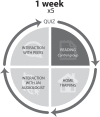Evaluating the short-term and long-term effects of an internet-based aural rehabilitation programme for hearing aid users in general clinical practice: a randomised controlled trial
- PMID: 28592571
- PMCID: PMC5734201
- DOI: 10.1136/bmjopen-2016-013047
Evaluating the short-term and long-term effects of an internet-based aural rehabilitation programme for hearing aid users in general clinical practice: a randomised controlled trial
Abstract
Objective: Guided internet-based intervention beyond hearing aid (HA) fitting has been shown to be efficacious in randomised controlled trials (RCTs). However, internet interventions have rarely been applied clinically as a part of regular aural rehabilitation (AR). Our aim was to evaluate the effectiveness of internet-based AR for HA users from a clinical population.
Outcome measures: The Hearing Handicap Inventory for the Elderly (HHIE) was used as the primary outcome measure, and the Communication Strategies Scale (CSS) and the Hospital Anxiety and Depression Scale were used as secondary outcome measures. All questionnaires were administered before and directly after the intervention and at 6 months postintervention.
Methods: We used a parallel group design (RCT). The data were collected in 2013-2014 at three different clinics. Seventy-four HA users were randomly assigned to receive either full internet-based AR (intervention group, n=37) or one element of the internet-based AR (control group, n=37).
Results: Data were analysed following the intention-to-treat principle. Each group showed improved HHIE scores over time and did not differ significantly from each other. The intervention group showed significantly greater improvement compared with the control group for the CSS total and the non-verbal subscale scores. The intervention group and control group were also subdivided into two age groups: 20-59 years and 60-80 years. Significantly better improvement on the CSS total and non-verbal subscale scores was found in the older group compared with the younger participants.
Conclusions: This study indicates that participants in an internet-based intervention applied in general clinical practice showed improved self-reported communication skills compared with a control group. Receiving a full intervention was not more effective in improving self-reported hearing problems than receiving just one element of the internet-based intervention.
Trial registration number: This trial is registered at ClinicalTrals.gov, NCT01837550; results.
Keywords: audiology; aural rehabilitation; clinical practice; hearing loss; internet.
© Article author(s) (or their employer(s) unless otherwise stated in the text of the article) 2017. All rights reserved. No commercial use is permitted unless otherwise expressly granted.
Conflict of interest statement
Competing interests: None declared.
Figures


Similar articles
-
A randomized, controlled trial of the short-term effects of complementing an educational program for hearing aid users with telephone consultations.J Am Acad Audiol. 2011 Nov-Dec;22(10):654-62. doi: 10.3766/jaaa.22.10.4. J Am Acad Audiol. 2011. PMID: 22212765 Clinical Trial.
-
A randomised, controlled trial of clinically implementing online hearing support.Int J Audiol. 2023 May;62(5):472-480. doi: 10.1080/14992027.2022.2059712. Epub 2022 Apr 18. Int J Audiol. 2023. PMID: 35436174 Clinical Trial.
-
Rehabilitative online education versus internet discussion group for hearing aid users: a randomized controlled trial.J Am Acad Audiol. 2011 May;22(5):274-85. doi: 10.3766/jaaa.22.5.4. J Am Acad Audiol. 2011. PMID: 21756843 Clinical Trial.
-
Novel Augmentation Strategies in Major Depression.Dan Med J. 2017 Apr;64(4):B5338. Dan Med J. 2017. PMID: 28385173 Review.
-
Audiological Rehabilitation for Facilitating Hearing Aid Use: A Review.J Am Acad Audiol. 2017 Mar;28(3):248-260. doi: 10.3766/jaaa.16035. J Am Acad Audiol. 2017. PMID: 28277215 Review.
Cited by
-
Effectiveness of a Web-Based SUpport PRogram (SUPR) for Hearing Aid Users Aged 50+: Two-Arm, Cluster Randomized Controlled Trial.J Med Internet Res. 2020 Sep 22;22(9):e17927. doi: 10.2196/17927. J Med Internet Res. 2020. PMID: 32960175 Free PMC article. Clinical Trial.
-
Process Evaluation of an Online SUpport PRogram for Older Hearing Aid Users Delivered in a Cluster Randomized Controlled Trial.Front Med (Lausanne). 2021 Oct 22;8:725388. doi: 10.3389/fmed.2021.725388. eCollection 2021. Front Med (Lausanne). 2021. PMID: 34746173 Free PMC article.
-
The Chronic Care Model and Chronic Condition Self-Management: An Introduction for Audiologists.Semin Hear. 2019 Feb;40(1):7-25. doi: 10.1055/s-0038-1676780. Epub 2019 Feb 5. Semin Hear. 2019. PMID: 30728646 Free PMC article. Review.
-
Efficacy of the Web-Based Swedish Individualized Active Communication Education (I-ACE) Program in First-Time Hearing Aid Users: Randomized Controlled Trial.J Med Internet Res. 2025 Jul 25;27:e71975. doi: 10.2196/71975. J Med Internet Res. 2025. PMID: 40711806 Free PMC article. Clinical Trial.
-
Impact of hearing rehabilitation programs on presbycusis management: a systematic review and meta-analysis of randomized controlled trials.Front Aging. 2024 Oct 21;5:1299964. doi: 10.3389/fragi.2024.1299964. eCollection 2024. Front Aging. 2024. PMID: 39497940 Free PMC article.
References
-
- World Health Organization. International classification of functioning, disability and Health (ICF). Geneva: World Health Organization, 2001.
Publication types
MeSH terms
Associated data
LinkOut - more resources
Full Text Sources
Other Literature Sources
Medical
Research Materials
